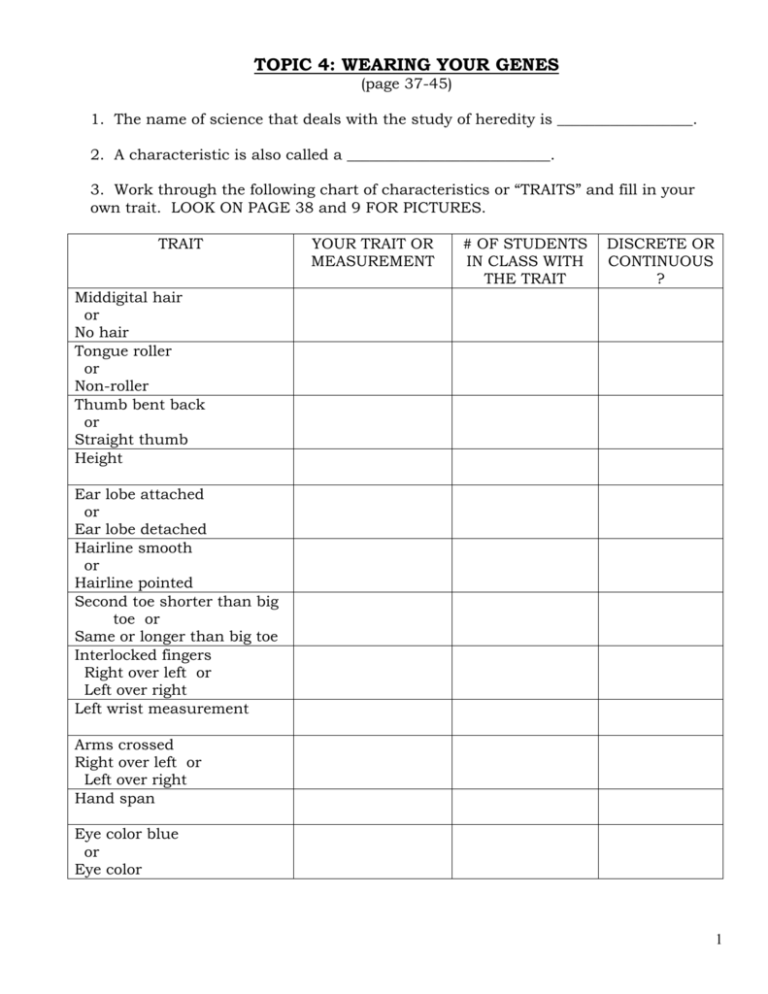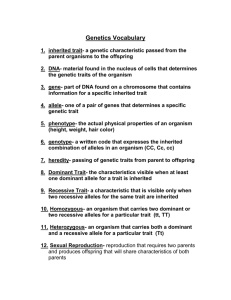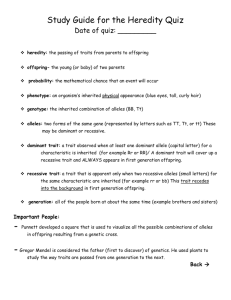TOPIC 4: WEARING YOUR GENES
advertisement

TOPIC 4: WEARING YOUR GENES (page 37-45) 1. The name of science that deals with the study of heredity is __________________. 2. A characteristic is also called a ___________________________. 3. Work through the following chart of characteristics or “TRAITS” and fill in your own trait. LOOK ON PAGE 38 and 9 FOR PICTURES. TRAIT YOUR TRAIT OR MEASUREMENT # OF STUDENTS IN CLASS WITH THE TRAIT DISCRETE OR CONTINUOUS ? Middigital hair or No hair Tongue roller or Non-roller Thumb bent back or Straight thumb Height Ear lobe attached or Ear lobe detached Hairline smooth or Hairline pointed Second toe shorter than big toe or Same or longer than big toe Interlocked fingers Right over left or Left over right Left wrist measurement Arms crossed Right over left or Left over right Hand span Eye color blue or Eye color 1 4. Traits can be classified into two groups: CONTINUOUS VARIATION Definition: i.e. DISCRETE VARIATION Definition: i.e. 5. Would hair color be discrete or continuous? Why? 6. List all the blood types possible (see poster if needed). Would blood type be discrete variation or continuous variation? Why? GREGOR MENDEL: MENDELS LAW OF HEREDITY 1. Each trait is controlled by two factors-genes (one from each parent) 2. Each gene had two forms (alleles): dominant and recessive) 3. For each trait an organism could inherit either: two dominant alleles two recessive alleles one dominant and one recessive allele 4. The distribution of dominant and recessive genes from the parents to the offspring was determined by chance 7. DOMINANT TRAIT is ________________________________________________________ _____________________________________________________________________________ i.e.: E is the symbol representing the dominant trait for detached earlobe EE or Ee will have the dominant trait showing up. 8. RECESSIVE TRAIT is ________________________________________________________ __________________________________________________________________________ i.e.: e is the symbol representing the recessive trait for attached ear lobes ee is needed for the recessive trait to show up. RECESSIVE TRAIT DOMINANT TRAIT 2 GET INFORMATION FROM THE BOARD NOTES: 9. We are all made up of _______________ , and inside each cell is the __________. 10. The nucleus contains ___________________________________ (_________ for humans) 11. These __________________________ are made up of GENES (A CODE)- a unit of heredity (the instructions that control the development of traits. 12. Genes have _________ forms called ALLELES (dominant and recessive): genetic material passed from parent to child and you get one from each parent. 13. _____________________________: is the outward appearance or trait. (attached or detached ear lobe) It is what you see! 14. _____________________________: is the genetic combination of alleles (the genetic makeup) EE or Ee or ee 15. _____________________________: when the genotype has both the same alleles. EE: two dominant alleles would show the ____________________________ trait. ee: two recessive alleles would show the _____________________________ trait. 16. _____________________________: when the genotype has one of each type of allele Ee: one recessive and dominant allele would show the ______________________ trait because this trait takes charge. 17. Tongue rolling is a dominant trait; the genotype would have at least one _____________________________________. 18. How many dominant alleles are needed to get a dominant trait? 19. List the possible genotypes for tongue rollers, if R represented the dominant allele and r represented the recessive allele. 20. How many recessive alleles are needed to have the phenotype of a recessive trait? 21. List the genotype for a non-tongue roller. 22. If a trait was wide spread in a population is the trait dominant or recessive? Explain. (page 40) 23. Not all traits are controlled by one pair of genes. Hair color is controlled by several genes, so the study of these traits is difficult. It is known as quantitative inheritance. 3 24. Traits are also known to blend to make a third trait (i.e. Red short horn cow and a white short horn bull can have a red roan offspring) This is known as incomplete dominance. 25. Sex-linked traits: are connected to the X or Y chromosome (X chromosome is larger). Examples are: color-blindness (red-green-mostly males), hemophilia (are usually males as the female is the carrier), voice (masculine, etc.) 26. A _____________ _____________ can be used to see the genotype possibilities of offspring traits. 27. Complete the squares below for tongue rollers. -”R” representing the dominant trait -”r” representing the recessive trait. HOMOZYGOUS DOMINANT PARENTS ♀\♂ R R R R HOMOZYGOUS RECESSIVE PARENTS ♀\♂ r r r r You get ____ out of 4 that shows the dominant trait and ____out of 4 that shows the recessive trait. You get ____ out of 4 that shows the dominant trait and ____out of 4 that shows the recessive trait. HOMOZYGOUS DOMINANT AND HOMOZYGOUS RECESSIVE PARENT TWO HETEROZYGOUS PARENTS ♀\♂ R r r R You get ____ out of 4 that shows the dominant trait and ____out of 4 that shows the recessive trait. ♀\♂ R R r r You get ____ out of 4 that shows the dominant trait and ____out of 4 that shows the recessive trait 28. If you had a trait that neither of your parents had, how could you explain it? 4 EXPLORING GENETIC POSSIBILITIES GIVE IT A TRY FROM SCIENCE IN ACTION: In sexual reproduction, chromosomes are inherited in pairs: one pair from each parent. In an offspring, the two chromosomes line up so that the gene locations match. In fruit flies, there are two possible alleles for leg length (long leg and short leg) a. Suppose a fruit fly inherits two long leg alleles. Will the fruit fly develop long legs or short legs? Explain why. b. Suppose a second fruit fly inherits two copies of the short leg allele. Will this fruit fly develop long legs or short legs? Explain why. c. Suppose a third fruit fly inherits one short leg allele and one long leg allele. Will the fruit fly have long legs or short legs? Explain your answer. In fruit flies, there are two possible alleles for eye color: red eye and purple eye. d. List three possible ways to pair these alleles. e. For each pair, what eye color would you expect an offspring to develop? Explain why you cannot be sure in all three cases. In fruit flies, there are two possible alleles for wing shape: long wing and dumpy wing. f. List three possible ways that these alleles might be paired in the offspring. g. For each pair, what wing shape would you expect an offspring to develop? Explain why you cannot be sure in all three cases. 29. An individual fly might have long legs, purple eyes and long wings. What other combinations of leg length, eye color and wing shape are possible? 5 30. Explain polydactyl. Is it discrete or continuous? Dominant or recessive? 31. Explain the difference between: nature and nurture and give examples of each. NATURE NURTURE 32. Which is not inherited: nature or nurture traits? 33. Give an example of a trait that is affected by both nature and nurture. Explain. 34. Explain how scientists are trying to separate nature and nurture traits. 35. Explain the difference between mutation and mutagen. Give a three examples of each. MUTATION MUTAGEN 36. Read “Did You Know” on page 43. Explain the mutation and its benefit. 37. Cancer is caused by a mutation. Explain what a cancerous cell does and what it affects. 38. Are most mutations favorable or unfavorable? What do you think happens to most organisms with a mutation? (i.e.: albino deer) 6









